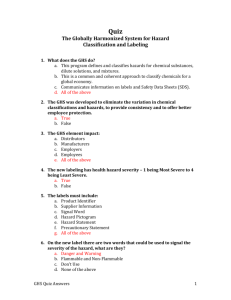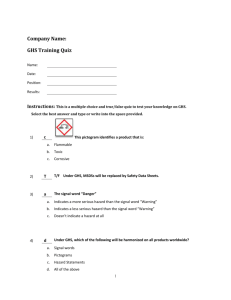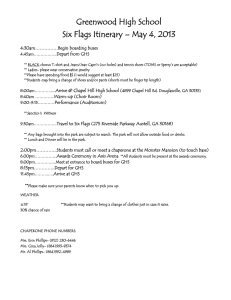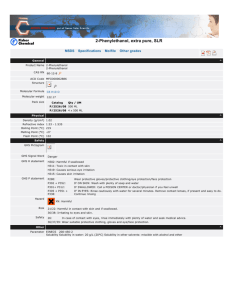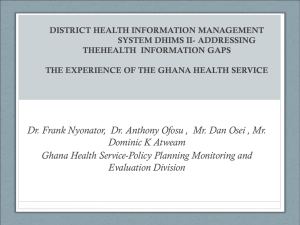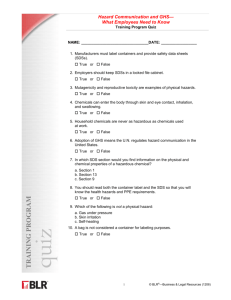- ePrints Soton
advertisement
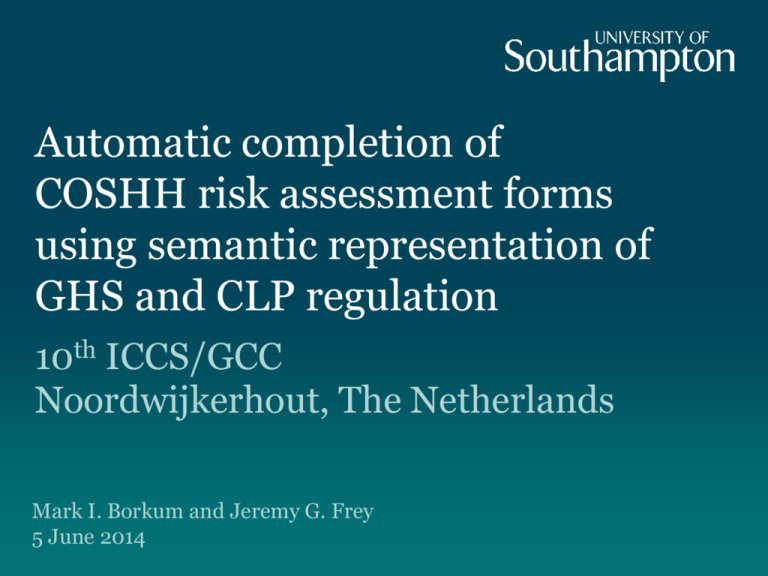
Automatic completion of COSHH risk assessment forms using semantic representation of GHS and CLP regulation 10th ICCS/GCC Noordwijkerhout, The Netherlands Mark I. Borkum and Jeremy G. Frey 5 June 2014 Overview • Problem Statement • Methodology • Results • Discussion • Conclusion and Future Work 2 Risk Assessment • Risk assessment is the determination of the risk associated with a given hazard. • In the context of chemistry research, risk assessment determines the risk associated with chemical hazards, e.g., – Explosive, – Flammable, – Carcinogenic, – etc. 3 COSHH • The Control of Substances Hazardous to Health (COSHH) Regulations 2002 are a UK statutory instrument. • COSHH requires employers to protect their employees from the effects of exposure to hazardous chemical substances. – (The main mechanism for this is risk assessment.) 4 c/o SmartTea project 5 COSHH Risk Assessment Methodology 0. Plan scientific experiment. 1. Enumerate collection of chemical substances. 2. Discover relevant health and safety information. 3. Interpolate assessment form template. c/o SmartTea project 6 GHS • The Globally Harmonized System for Classification and Labelling of Chemicals (GHS) is a UN system. – Designed to supersede the various C&L systems that are currently in use around the world. 7 CLP Regulation • In the EU, the GHS is implemented as the CLP Regulation (see: Regulation (EC) No 1272/2008). – Came into force in January 2009. – Mandatory from June 2015. 8 Problem Statement • For humans, performing a risk assessment has two main drawbacks: – Less time spent performing experiments; and, – Potential for human error, e.g., • • • • Incomplete enumeration of chemical substances; Use of incorrect information; Transcription errors; and, Tacit assumption of “common” elements. 9 Let’s Automate! Automation Strategy • Given a description of a scientific experiment: 1. Discover and resolve all chemical identifiers; 2. Aggregate relevant health and safety information; and, 3. Feed the results through a template. 11 12 Methodology 1. Formalise content of CLP Regulation document: – Annex I Definitions – Annexes III—V Instances (C&L elements) – Annex VI Instances (classifications for approx. 3000 chemical substances and mixtures) 2. Implement Web application. 3. Profit! 13 Resource Description Framework (RDF) http://www.w3.org/TR/rdf11-primer/example-graph.jpg 14 “ghs” Ontology 15 “Flammable solid. Category 1” 16 “EC (No) 007-001-01-2” Danger H314 hasSignalWord STOT SE 3 hasHazardStatement H335 hasHazardStatement hasHazardCategory Warning H400 hasHazardStatement hasSignalWord C ≥ 5% Skin Corr. 1B hasHazardClass Skin Corr. hasHazardCategory hasHazardCategory hasSubstance hasHazardPictogram GHS05 ammonia …% Aquatic Acute 1 hasHazardPictogram GHS09 hasHazardClass Aquatic 17 “(EC) No 001-001-00-9” 18 Results • Dataset is available at: – http://bit.ly/1fvDO5u • Provides descriptions of approx. 3000 chemical substances and mixtures. – However, on its own, the dataset is not very practical (for use in production environments). – The critical observation is that, for many researchers, chemical substances are procured. • In Autumn 2013, we approached a major supplier... 19 20 “12540 FLUKA” @base <http://www.sigmaaldrich.com/catalog/product/> . @prefix chemaxiomprop: <http://www.polymerinformatics.com/ChemAxiom/ChemAxiomProp.owl#> . @prefix chemdomain: <http://www.polymerinformatics.com/ChemAxiom/ChemDomain.owl#> . @prefix ghs: <http://xmlns.com/ghs/0.1/> . @prefix sial: <http://www.sigmaaldrich.com/ns#> . <fluka/12540> a chemdomain:NamedChemicalSpecies; chemdomain:hasIdentifier [ a sial:ChemicalNumber; chemdomain:hasValue "042802"], [ a chemdomain:Name; chemdomain:hasValue "Benzene"], [ a chemdomain:CASNumber; chemdomain:hasValue "71-43-2"], [ a chemdomain:SMILES; chemdomain:hasValue "c1ccccc1"], [ a chemdomain:MolecularFormula; chemdomain:hasValue "C6H6"]; ghs:hasHazardCategory <http://id.unece.org/ghs/hazard_categories/Flam_Liq_2>, <http://id.unece.org/ghs/hazard_categories/SPEC_RE_1>, <http://id.unece.org/ghs/hazard_categories/Skin_Irrit_2>, <http://id.unece.org/ghs/hazard_categories/Carc_1A>, <http://id.unece.org/ghs/hazard_categories/Asp_Tox_1>, <http://id.unece.org/ghs/hazard_categories/Eye_Irrit_2>, <http://id.unece.org/ghs/hazard_categories/Muta_1B> . 21 Red square = Chemical substance Orange square = Mixture part Green square = PPE product Blue square = GHS hazard category 22 Demo List of Technologies • Web technologies: – JavaScript Object Notation (JSON) – Representational State Transfer (REST) • Semantic Web technologies: • Programming languages: – JavaScript – Ruby • Libraries: – Resource Description Framework (RDF) – handlebars.js – SPARQL Query Language for RDF (SPARQL) – RDF.rb – Web Ontology Language (OWL) – jQuery / jQuery UI – Sinatra 24 Software Architecture 25 1) Load Web application “Generate” button is disabled 26 2) Search for products by name Dynamic search with autocompletion 27 2) Search for products by name Selected product is added to list Link to Sigma-Aldrich product page 28 3) Accept terms and conditions “Generate” button is enabled 29 Editable text fields for “Physical Form” and “Quantity” One row per product Editable text area for “Nature of Process” The University requires that assessment forms are printed and signed 30 Toggle visibility of classification and labelling elements Integration with purchasing platform 31 Sigma-Aldrich one page safety data sheet (“one pager”) 32 Discussion Stakeholders 34 The Wrong Question • Who is to blame when the end-user obtains and relies upon the “correct” answer to the “incorrect” question? – User Can I drink this poison? – System Yes – User Is it safe to drink this poison? – System No 35 Conclusion Conclusion • If you have high-quality, machine accessible chemical information, automated completion of risk assessment forms templates is trivial. • Need to mitigate risk of end-users relying on correct answers to incorrect questions. – Use disclaimers – Capture and curate provenance information • Try to collaborate with chemical manufacturers, suppliers, transporters, etc. They have large volumes of relevant data. 37 Future Work • Approach UN/EC to host dataset. • Enhanced input for service, either: – List of “chemical identifier—phase—quantity” triples; or, – Whole “plan” for scientific experiment. • Full-blown Web application with template designer. • RDF formalisation of Sigma-Aldrich “product catalog.” 38 Acknowledgements • University of Southampton: Doug Akins, Phil Jewell • Sigma-Aldrich: Bo Jin, Jane Murray, Tom Pieper, Judith Pruss 39
